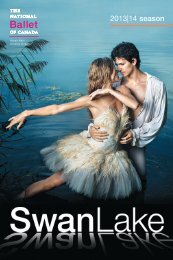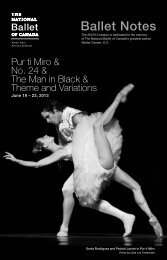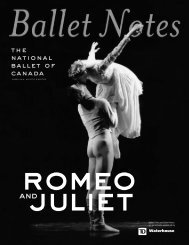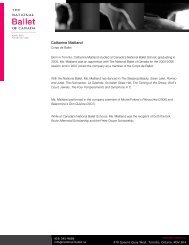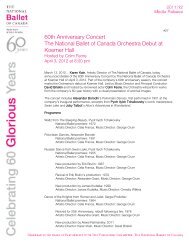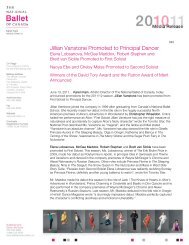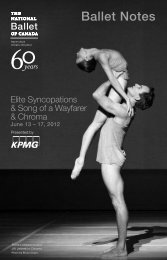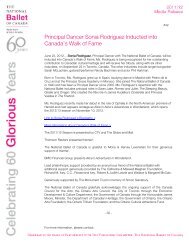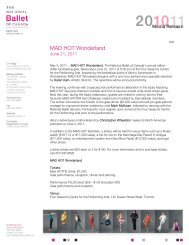Romeo and Juliet - The National Ballet of Canada
Romeo and Juliet - The National Ballet of Canada
Romeo and Juliet - The National Ballet of Canada
Create successful ePaper yourself
Turn your PDF publications into a flip-book with our unique Google optimized e-Paper software.
Mailing Address<br />
<strong>The</strong> Walter Carsen Centre for<br />
<strong>The</strong> <strong>National</strong> <strong>Ballet</strong> <strong>of</strong> <strong>Canada</strong><br />
470 Queens Quay West<br />
Toronto, Ontario<br />
<strong>Canada</strong> M5V 3K4<br />
Phone<br />
416 345 9686 x359<br />
Email<br />
jcameron@national.ballet.ca<br />
Guillaume Côté as <strong>Romeo</strong>, Patrick Lavoie as Paris <strong>and</strong> Heather Ogden as <strong>Juliet</strong> | Photo by Cylla von Tiedemann<br />
Grades 4 to 12<br />
<strong>The</strong> <strong>National</strong> <strong>Ballet</strong> <strong>of</strong> <strong>Canada</strong> is pleased to<br />
provide this guide to assist teachers <strong>and</strong><br />
students in their study <strong>of</strong> <strong>Romeo</strong> <strong>and</strong> <strong>Juliet</strong>.<br />
Guiding your class though some <strong>of</strong> these<br />
activities before, during <strong>and</strong> after the<br />
performance will enhance their experience,<br />
promoting a deeper underst<strong>and</strong>ing <strong>and</strong><br />
appreciation <strong>of</strong> ballet. It is highly recommended<br />
that a selection <strong>of</strong> these curriculum-based<br />
activities be carried out so that students<br />
may receive optimal benefit <strong>and</strong> enjoyment<br />
from the performance.<br />
Study Guide<br />
<strong>Romeo</strong> <strong>and</strong> <strong>Juliet</strong><br />
Table <strong>of</strong> Contents<br />
1 <strong>The</strong> Main Characters<br />
2 Synopsis<br />
3 Historical Note<br />
4 Pre-Performance Activities<br />
5 Post-Performance Activities<br />
6 Teacher <strong>and</strong> Student Resources<br />
7 H<strong>and</strong>outs
<strong>The</strong> Main Characters<br />
<strong>The</strong> House <strong>of</strong> Capulet<br />
<strong>Juliet</strong><br />
Young <strong>Juliet</strong> is the only daughter <strong>of</strong> Lord<br />
<strong>and</strong> Lady Capulet. About to turn 14, <strong>Juliet</strong> is<br />
attending her first ball. Though youthful <strong>and</strong><br />
innocent, <strong>Juliet</strong>, like many girls in Renaissance<br />
times, must choose a husb<strong>and</strong> to marry.<br />
Though brought up as a noble <strong>and</strong> dignified<br />
young woman, she is also strong willed. Her<br />
rebellious nature propels her to fall in love at<br />
first sight with <strong>Romeo</strong>, a Montague whose<br />
family is feuding with hers.<br />
Lord Capulet<br />
<strong>The</strong> father <strong>of</strong> <strong>Juliet</strong>, Lord Capulet is the<br />
head <strong>of</strong> a very important Veronese family <strong>of</strong><br />
the 14th century. Though a loving father,<br />
Lord Capulet is very authoritarian <strong>and</strong><br />
dem<strong>and</strong>ing. He is serious <strong>and</strong> steadfast <strong>and</strong><br />
will not be rebuked.<br />
Lady Capulet<br />
<strong>The</strong> mother <strong>of</strong> <strong>Juliet</strong>, Lady Capulet is a regal<br />
<strong>and</strong> noble woman. She was very young<br />
when she gave birth to <strong>Juliet</strong> <strong>and</strong> is still only<br />
about 28 or 30 years old. Lady Capulet is<br />
rather cold hearted <strong>and</strong> formal <strong>and</strong> doesn’t<br />
seem to underst<strong>and</strong> the needs <strong>of</strong> her<br />
romantic young daughter. Probably forced<br />
into an arranged marriage herself, Lady<br />
Capulet is unsympathetic to what true love<br />
is all about. She is also very ambitious <strong>and</strong><br />
calculating <strong>and</strong> wants above all for her<br />
daughter to marry a wealthy nobleman.<br />
Lady Capulet despises the Montagues,<br />
almost as much as her nephew Tybalt does.<br />
Tybalt<br />
Tybalt is <strong>Juliet</strong>’s cousin. He is not a very<br />
likeable character, for he is hot-tempered<br />
enjoys provoking others. Tybalt is full <strong>of</strong><br />
hatred toward all the Montagues, including<br />
<strong>Romeo</strong>, <strong>and</strong> is always ready to start a fight.<br />
As his name implies, this man is tyrannical,<br />
cruel <strong>and</strong> powerful. Shakespeare calls him<br />
the “prince <strong>of</strong> cats.”<br />
Victoria Bertram as Lady Capulet <strong>and</strong> Heather Ogden as <strong>Juliet</strong> |<br />
Photo by Cylla von Tiedemann<br />
Nurse<br />
Since she was a baby, <strong>Juliet</strong> has been<br />
reared by her Nurse, who is not only<br />
motherly to <strong>Juliet</strong>, but is also her friend <strong>and</strong><br />
confidante. <strong>The</strong> Nurse is a rolly-polly older<br />
woman who is talkative <strong>and</strong> lively <strong>and</strong> who<br />
loves gossip <strong>and</strong> intrigue. Loyal to young<br />
<strong>Juliet</strong>, the Nurse acts as the go-between for<br />
the lovers.<br />
Paris<br />
Count Paris is betrothed to <strong>Juliet</strong>. He is a<br />
young, h<strong>and</strong>some <strong>and</strong> rich nobleman. In<br />
Renaissance times, arranged marriages<br />
were not uncommon <strong>and</strong> more <strong>of</strong>ten than<br />
not the young couple didn’t even have a<br />
chance to meet before their wedding day.<br />
By marrying <strong>Juliet</strong> to Paris, her parents<br />
mean to assure her wealth <strong>and</strong> a position in<br />
society. Luckily, <strong>Juliet</strong> does have an<br />
opportunity to meet Paris before their<br />
wedding day; she dances with Paris at the<br />
ball <strong>and</strong> finds that he is kind, but rather dull<br />
<strong>and</strong> cardboard-like, with no real personality.
<strong>The</strong> House <strong>of</strong> Montague<br />
<strong>Romeo</strong><br />
As his name implies, <strong>Romeo</strong> (romeo =<br />
romance) is a romantic. Almost 20 years<br />
old, <strong>Romeo</strong> is a rather idle young man with<br />
no true purpose in life. <strong>The</strong> aristocratic son<br />
<strong>of</strong> Lord <strong>and</strong> Lady Montague, <strong>Romeo</strong> is not<br />
only a romantic, but also rather moody <strong>and</strong><br />
melancholic. He is very introspective <strong>and</strong><br />
spends his time moping about Verona.<br />
<strong>Romeo</strong> lives lost in a dream world <strong>and</strong>, like<br />
the true idealist, is in love with love. When<br />
we first meet <strong>Romeo</strong>, he is flirting with<br />
Rosalind, but his attraction to her is nothing<br />
but a diversion <strong>of</strong> the moment <strong>and</strong> is lost<br />
when he sets eyes on <strong>Juliet</strong>. He is suddenly<br />
intoxicated by a love that transforms this<br />
h<strong>and</strong>some <strong>and</strong> passionate youth into a man<br />
filled with tenderness, generosity <strong>and</strong> love.<br />
But <strong>Romeo</strong>’s passion <strong>and</strong> high-strung<br />
energy prove dangerous <strong>and</strong> bring him<br />
much sadness through the deaths <strong>of</strong> his<br />
best friend, Mercutio, <strong>and</strong> his bride, <strong>Juliet</strong>.<br />
Lord Montague<br />
<strong>The</strong> father <strong>of</strong> <strong>Romeo</strong>, Lord Montague is an<br />
older man, wise <strong>and</strong> calm. Though for many<br />
years his family has been feuding with that<br />
<strong>of</strong> the Capulets, Lord Montague is not a<br />
violent man <strong>and</strong> he would much rather see<br />
peace in Verona.<br />
Lady Montague<br />
<strong>The</strong> mother <strong>of</strong> <strong>Romeo</strong> <strong>and</strong> wife <strong>of</strong> Lord<br />
Montague, Lady Montague is calm, quiet,<br />
regal <strong>and</strong> dignified. Unlike the haughty <strong>and</strong><br />
domineering Lady Capulet, Lady Montague<br />
is peace-loving.<br />
Keiichi Hirano as Benvolio, Piotr Stanczyk as Mercutio <strong>and</strong><br />
Guillaume Côté as <strong>Romeo</strong> | Photo by Cylla von Tiedemann<br />
Mercutio<br />
Mercutio’s name is very revealing <strong>of</strong> his<br />
character. As William Shakespeare notes in<br />
his play Love’s Labour’s Lost, “the words <strong>of</strong><br />
Mercury are harsh.” And like his namesake,<br />
the Roman god Mercury, Mercutio is wild,<br />
witty, impulsive <strong>and</strong> quick with his tongue.<br />
Above all, Mercutio is <strong>Romeo</strong>’s best <strong>and</strong><br />
truest friend. All <strong>of</strong> Mercutio’s wonderfully<br />
spirited energy causes him to be rather<br />
volatile <strong>and</strong> fiery, which gets him into<br />
trouble. He seems flippant <strong>and</strong> light-hearted<br />
about everything, acting as if nothing is very<br />
serious, yet he has a heart <strong>of</strong> gold <strong>and</strong> is a<br />
loyal friend.<br />
Benvolio<br />
Benvolio’s name also gives a clue to this<br />
man’s nature, for he is truly a do-gooder.<br />
He is benevolent, wise, moderate <strong>and</strong><br />
peace loving. It is Benvolio who is<br />
constantly cautioning his friends <strong>Romeo</strong><br />
<strong>and</strong> Mercutio <strong>and</strong> acting as a pacifist in<br />
their quarrels with Tybalt.
Duke <strong>of</strong> Verona<br />
A stately older man, the Duke rules over the<br />
people <strong>of</strong> Verona <strong>and</strong> represents law <strong>and</strong><br />
order. He does not take sides in the family<br />
feud, but even this upholder <strong>of</strong> justice<br />
cannot stop the bloodshed in Verona, which<br />
he calls a “cankered hate.”<br />
Friar Laurence<br />
Friar Laurence is a Franciscan monk. <strong>The</strong><br />
Friar lives a good <strong>and</strong> simple life <strong>of</strong> prayer<br />
<strong>and</strong> meditation. He is a calm, affectionate<br />
<strong>and</strong> wise holy man, who takes no side in the<br />
feud <strong>of</strong> the Montagues <strong>and</strong> Capulets <strong>and</strong> is<br />
therefore a friend <strong>and</strong> confidant to all. <strong>The</strong><br />
Friar would like to see an end to the feud<br />
<strong>and</strong> is therefore willing to marry <strong>Romeo</strong> <strong>and</strong><br />
<strong>Juliet</strong> in the hope that their love will end the<br />
bloodshed <strong>and</strong> hatred in Verona. Friar<br />
Laurence, like many monks <strong>of</strong> his day, is a<br />
scholar, scientist, philosopher <strong>and</strong> medicine<br />
man, a healer who works with herbs. He<br />
truly represents the spiritual nature <strong>of</strong> a torn<br />
community.<br />
Guillaume Côté as <strong>Romeo</strong>, Peter Ottmann as Friar Laurence <strong>and</strong> Heather Ogden as <strong>Juliet</strong> | Photo by Cylla von Tiedemann
Synopsis<br />
Two households, both alike in dignity,<br />
In fair Verona, where we lay our scene,<br />
From ancient grudge break to new mutiny,<br />
Where civil blood make civil h<strong>and</strong>s<br />
unclean...<br />
Act I<br />
Scene 1: A Street in Verona, Italy<br />
<strong>The</strong> scene is set in the early Renaissance,<br />
about 1400. <strong>Romeo</strong>, son <strong>of</strong> Lord Montague,<br />
is infatuated with Rosalind <strong>and</strong> flirts with her<br />
in the courtyard. <strong>The</strong> city begins to awaken<br />
<strong>and</strong> the townspeople open the market for<br />
trade. But all is not peaceful. <strong>The</strong> city’s two<br />
most powerful families, the Capulets <strong>and</strong><br />
the Montagues are feuding bitterly. Playful<br />
teasing soon turns into a brawl as members<br />
<strong>of</strong> the opposing families draw swords <strong>and</strong><br />
begin to fight. <strong>Romeo</strong> joins his friends,<br />
Mercutio <strong>and</strong> Benvolio, <strong>and</strong> the three become<br />
involved in the brawl. <strong>The</strong> riot is quelled by<br />
the arrival <strong>of</strong> the Duke <strong>of</strong> Verona, who<br />
decrees the death penalty if either family<br />
disturbs the peace again.<br />
Scene 2: <strong>The</strong> Capulet’s Garden<br />
<strong>Juliet</strong>, the young daughter <strong>of</strong> Lord Capulet,<br />
plays with her Nurse. Her mother joins them<br />
bringing <strong>Juliet</strong> the dress she is to wear that<br />
evening to her first ball. Excited, <strong>Juliet</strong><br />
dances about with her dress, but stops<br />
suddenly when she realizes that her carefree<br />
childhood is coming to an end.<br />
Scene 3: <strong>The</strong> Foyer <strong>of</strong> the Capulet’s<br />
Palace<br />
Elegant guests arrive at the ball. Although<br />
not invited, <strong>Romeo</strong>, Mercutio <strong>and</strong> Benvolio<br />
boldly make their way into the foyer,<br />
cloaked <strong>and</strong> masked as revellers.<br />
Scene 4: <strong>The</strong> Capulet’s Ballroom<br />
<strong>Juliet</strong> shyly arrives at the ball <strong>and</strong> is<br />
introduced to Count Paris, to whom she is<br />
betrothed. While <strong>Juliet</strong> is dancing with Paris,<br />
she <strong>and</strong> <strong>Romeo</strong> see one another for the first<br />
time <strong>and</strong> fall in love. <strong>The</strong>y steal a few<br />
moments together away from the guests<br />
until Tybalt, <strong>Juliet</strong>’s cousin, recognizes<br />
<strong>Romeo</strong> <strong>and</strong> challenges him to a duel. Lord<br />
Capulet stops the disturbance.<br />
Scene 5: <strong>Juliet</strong>’s Balcony<br />
Later the same night <strong>Romeo</strong> hides in the<br />
Capulet garden <strong>and</strong> overhears <strong>Juliet</strong><br />
pr<strong>of</strong>essing her love for him. <strong>Romeo</strong> reveals<br />
himself to <strong>Juliet</strong> <strong>and</strong> the young lovers swear<br />
their eternal devotion.<br />
Act II<br />
Scene 1: A Street in Verona<br />
Verona is celebrating a festive holiday.<br />
<strong>Juliet</strong>’s Nurse finds her way through the<br />
crowd in search <strong>of</strong> <strong>Romeo</strong> to give him a<br />
note from her mistress. <strong>Juliet</strong> has agreed to<br />
meet <strong>Romeo</strong> secretly in Friar Laurence’s<br />
cell where they can be married.<br />
Scene 2: Friar Laurence’s Cell<br />
Friar Laurence marries the young lovers,<br />
hoping that this will end the feud between<br />
their two families.<br />
Scene 3: A Street in Verona<br />
<strong>The</strong> festivities are interrupted by Tybalt, who<br />
is intent upon resuming his quarrel with<br />
<strong>Romeo</strong>. <strong>Romeo</strong>, however, is aware that<br />
<strong>Juliet</strong>’s relatives are now his own, <strong>and</strong> so he<br />
avoids a duel with Tybalt. Mercutio,<br />
appalled at his friend’s apparent lack <strong>of</strong><br />
spirit, accepts Tybalt’s challenge on<br />
<strong>Romeo</strong>’s behalf. In attempting to stop the<br />
fight, <strong>Romeo</strong> inadvertently causes<br />
Mercutio’s death. Shocked out <strong>of</strong> his<br />
peaceful resolution, <strong>Romeo</strong> kills Tybalt,<br />
avenging his friend. Lady Capulet witnesses<br />
the death, <strong>and</strong> grieves passionately over her<br />
dead nephew.
Act III<br />
Scene 1: <strong>Juliet</strong>’s Bedroom<br />
<strong>Romeo</strong>, banished from Verona for killing<br />
Tybalt, has remained for his wedding night<br />
with <strong>Juliet</strong>. At dawn, he is forced to leave.<br />
<strong>Juliet</strong>’s parents enter with Paris <strong>and</strong> inform<br />
her that she is to marry Paris the next day.<br />
In desperation <strong>Juliet</strong> hurries away to seek<br />
advice from Friar Laurence.<br />
Scene 2: Friar Laurence’s Cell<br />
Reluctantly, Friar Laurence gives <strong>Juliet</strong> a vial<br />
containing a sleeping potion that will induce<br />
a death-like coma. He will send a message<br />
to <strong>Romeo</strong>, telling him what has happened,<br />
<strong>and</strong> he will return to rescue her from the<br />
family vault.<br />
Scene 3: <strong>Juliet</strong>’s Bedroom<br />
Filled with fear <strong>and</strong> doubts, <strong>Juliet</strong> forces<br />
herself to drink the potion <strong>and</strong> falls<br />
unconscious on the bed. In the morning<br />
<strong>Juliet</strong>’s bridesmaids arrive to present her<br />
with flowers. Lady Capulet <strong>and</strong> the Nurse<br />
are unable to wake <strong>Juliet</strong> <strong>and</strong> presume she<br />
is dead.<br />
Heather Ogden as <strong>Juliet</strong> <strong>and</strong> Guillaume Côté as <strong>Romeo</strong> | Photo by Cylla von Tiedemann<br />
Scene 4: <strong>The</strong> Capulet Vault<br />
<strong>Juliet</strong> is laid to rest in the Capulet Vault.<br />
<strong>Romeo</strong> has heard <strong>of</strong> <strong>Juliet</strong>’s death, but has<br />
not received Friar Laurence’s explanatory<br />
letter. He hurries to her tomb <strong>and</strong> finds Paris<br />
there. In desperation <strong>Romeo</strong> kills Paris.<br />
Believing <strong>Juliet</strong> to be dead, <strong>Romeo</strong> takes<br />
his own life. <strong>Juliet</strong>, recovering from the<br />
potion, is horrified to find <strong>Romeo</strong> dead<br />
beside her. Unable to live without him, she<br />
joins him in death.<br />
...never was a story <strong>of</strong> more woe<br />
Than this <strong>of</strong> <strong>Juliet</strong> <strong>and</strong> her <strong>Romeo</strong>
Historical Note<br />
First performed at La Scala in 1958 <strong>and</strong><br />
revised in 1962, John Cranko’s <strong>Romeo</strong> <strong>and</strong><br />
<strong>Juliet</strong> is among the best-loved <strong>and</strong> mostadmired<br />
ballet adaptations <strong>of</strong> William<br />
Shakespeare’s great drama <strong>of</strong> star-crossed<br />
love. Behind every movement, gesture, duet<br />
<strong>and</strong> interlude, the poetry <strong>of</strong> Shakespeare is<br />
whispered throughout <strong>Romeo</strong> <strong>and</strong> <strong>Juliet</strong>.<br />
Cranko’s ballet is one <strong>of</strong> the happiest<br />
marriages <strong>of</strong> literature <strong>and</strong> dance.<br />
Cranko himself mounted his ballet for <strong>The</strong><br />
<strong>National</strong> <strong>Ballet</strong> <strong>of</strong> <strong>Canada</strong> in 1964 <strong>and</strong> the<br />
work quickly became a signature piece for<br />
the company. Similarly, the title characters,<br />
so vividly created <strong>and</strong> emotionally compelling<br />
have over the years proved to be defining<br />
<strong>and</strong> signature roles for many <strong>of</strong> the<br />
company’s finest male <strong>and</strong> female dancers.<br />
<strong>The</strong> television film <strong>of</strong> that production, made<br />
by Norman Campbell <strong>and</strong> starring Veronica<br />
Tennant <strong>and</strong> Earl Kraul, won the Prix Rene<br />
Barthelemy at Monte Carlo in 1966.<br />
<strong>Romeo</strong> <strong>and</strong> <strong>Juliet</strong> was re-designed to<br />
spectacular effect by Susan Benson in 1995<br />
<strong>and</strong> it is this current production that the<br />
company dances today. Set to Sergei<br />
Prok<strong>of</strong>iev’s dramatically powerful score, the<br />
work remains an unforgettable <strong>and</strong><br />
incomparable embodiment <strong>of</strong> the yearning,<br />
ardour <strong>and</strong> innocence <strong>of</strong> adolescent passion.<br />
<strong>Romeo</strong> <strong>and</strong> <strong>Juliet</strong> was the first ballet performed<br />
by <strong>The</strong> <strong>National</strong> <strong>Ballet</strong> <strong>of</strong> <strong>Canada</strong> at Toronto’s<br />
O’Keefe Centre (now the Hummingbird Centre)<br />
on April 21, 1964. It was the first large-scale<br />
20th-century ballet, as well as the most<br />
lavish to enter the company’s repertoire,<br />
<strong>and</strong> was deliberately chosen to suit the<br />
large stage <strong>of</strong> the O’Keefe Centre. In 2006,<br />
<strong>Romeo</strong> <strong>and</strong> <strong>Juliet</strong> will mark the <strong>National</strong><br />
<strong>Ballet</strong>’s final performances at the Hummingbird<br />
Centre before moving to the Four Seasons<br />
Centre for the Performing Arts.<br />
Xiao Nan Yu as <strong>Juliet</strong> <strong>and</strong> Patrick Lavoie as <strong>Romeo</strong> | Photo by<br />
Cylla von Tiedemann<br />
For further information about <strong>Romeo</strong> <strong>and</strong><br />
<strong>Juliet</strong> please download the “<strong>Ballet</strong> Notes”<br />
for this production:<br />
http://www.national.ballet.ca/education.php?acti<br />
vities/balletNotes<br />
To learn more about <strong>The</strong> <strong>National</strong> <strong>Ballet</strong> <strong>of</strong><br />
<strong>Canada</strong> please go to the following page on<br />
our website:<br />
http://www.national.ballet.ca/about.php?nboc
Pre-Performance Activities<br />
1 Dance<br />
Personal Experience<br />
Through discussion or written response,<br />
reflect on the following:<br />
> What kinds <strong>of</strong> dancing have you done<br />
before?<br />
> When do you dance <strong>and</strong> why?<br />
> Have you ever made up a dance?<br />
> Have you danced solo?<br />
> Have you danced in a group?<br />
> Explain the meaning <strong>of</strong> the following<br />
phrase “universal language <strong>of</strong> dance.”<br />
2 Dance <strong>and</strong> Drama<br />
What is Dance?<br />
Through discussion or written response,<br />
reflect on the following:<br />
> What are some plays or live theatre<br />
productions you have seen?<br />
> Have you seen ballet performed before?<br />
> How is a story told through dance?<br />
> What is a ballet? What makes it<br />
different from other dancing?<br />
> Compare <strong>and</strong> contrast: How is telling a<br />
story through ballet the same/different<br />
from a live theatre play? A movie in a<br />
theatre? A television show at home? A<br />
book? Which do you prefer? Why?<br />
> Who decides how the dancers tell the<br />
story?<br />
> How do the dancers learn their parts?<br />
Visit the <strong>National</strong> <strong>Ballet</strong>’s website to help<br />
your students find the answers to these<br />
questions <strong>and</strong> more:<br />
http://www.national.ballet.ca/education.php?acti<br />
vities<br />
3 Dance <strong>and</strong> Drama<br />
Audience Etiquette<br />
Students should discuss audience etiquette<br />
before attending a live performance.<br />
Why do these rules exist? Relate accepted<br />
classroom management rules to appropriate<br />
audience etiquette. Consider a quick<br />
demonstration asking a few students to<br />
perform a short skit while the rest <strong>of</strong> the<br />
class misbehaves. Follow-up with a class<br />
discussion.<br />
Some important things to remember:<br />
> Turn <strong>of</strong>f all cell phones <strong>and</strong> pagers<br />
before the performance starts.<br />
> No cameras or other recording devices<br />
are allowed in the theatre.<br />
> Remain seated throughout the<br />
performance so that everyone can see.<br />
> Remain quiet so as to not distract the<br />
dancers <strong>and</strong> fellow audience members.<br />
> Clap politely at the end <strong>of</strong> the<br />
performance.<br />
For additional information on audience<br />
etiquette please visit:<br />
http://www.national.ballet.ca/education.php<br />
?att-performance<br />
4 Visual Arts, Language Arts <strong>and</strong> Music<br />
Listen, Draw <strong>and</strong> Write<br />
Sergei Prok<strong>of</strong>iev’s music for <strong>Romeo</strong> <strong>and</strong><br />
<strong>Juliet</strong> closely follows the structure <strong>of</strong> William<br />
Shakespeare’s original play. Play selections<br />
<strong>of</strong> music from Prok<strong>of</strong>iev’s <strong>Romeo</strong> <strong>and</strong> <strong>Juliet</strong><br />
(widely available on CD). Ask the students<br />
to draw images inspired by the music. <strong>The</strong>n,<br />
have them write two or three sentences<br />
describing what the music sounds like <strong>and</strong><br />
what the music makes them think about.<br />
Pay attention to the musical changes <strong>and</strong><br />
the moods evoked. Compare their thoughts<br />
with Shakespeare’s text for the same scene.
5 Dance<br />
Basic <strong>Ballet</strong> Steps<br />
Introduce the class to a small sample <strong>of</strong><br />
commonly seen ballet steps. Familiarity with<br />
basic ballet technique will provide students<br />
reference points to help students enjoy the<br />
performance. In <strong>Romeo</strong> <strong>and</strong> <strong>Juliet</strong> you will<br />
see following steps:<br />
Pas de deux: A dance for two dancers,<br />
usually one female <strong>and</strong> one male<br />
Bourrées: Tiny rapid steps performed by<br />
female dancers while on pointe, giving the<br />
illusion <strong>of</strong> floating above the ground<br />
Arabesque: One leg is stretched behind the<br />
body either on the ground or in the air at a<br />
90-degree angle or higher.<br />
Sauté: A jump from two feet to two feet.<br />
When a turn is added to the jump the step<br />
is called a Tour en l’air. <strong>The</strong> dancer can<br />
make 1, 2 or 3 revolutions in the air before<br />
l<strong>and</strong>ing.<br />
To see examples <strong>of</strong> these <strong>and</strong> other ballet<br />
steps please visit the following page on our<br />
website:<br />
http://www.national.ballet.ca/education.php?mor<br />
e/terms<br />
6 Dance <strong>and</strong> Drama<br />
Mime<br />
In a ballet performance there are typically<br />
no words spoken on the stage. <strong>The</strong> dancers<br />
must tell the audience the story (if there is a<br />
story) using only their body movements <strong>and</strong><br />
gestures, which they execute to the<br />
accompaniment <strong>of</strong> music. Often mime is<br />
used to relay specific elements <strong>of</strong> the story.<br />
Divide students into groups <strong>of</strong> two or more.<br />
Using the gestures found on the<br />
accompanying h<strong>and</strong>outs, students can<br />
create their own stories using mime <strong>and</strong><br />
perform them for the rest <strong>of</strong> the class. Can<br />
the audience follow the story?<br />
H<strong>and</strong>out included<br />
7 Dance, Drama, Health <strong>and</strong> Physical<br />
Education<br />
Dancers as Athletes<br />
But ballet is just for girls….<br />
When was the last time you lifted a person<br />
above your head <strong>and</strong> have it appear<br />
effortless?<br />
Or performed several gravity-defying leaps?<br />
<strong>Ballet</strong> can be enjoyed by boys, girls, men<br />
<strong>and</strong> women. It is very hard work <strong>and</strong><br />
requires great athletic ability, coordination<br />
<strong>and</strong> strength. Many dancers perform a 2 1/2<br />
hour ballet with only a few short breaks.<br />
Compare <strong>and</strong> contrast qualities <strong>of</strong><br />
pr<strong>of</strong>essional dancers to those <strong>of</strong><br />
pr<strong>of</strong>essional athletes.<br />
Make a list <strong>of</strong> qualities that are similar<br />
between a ballet dancer <strong>and</strong> any <strong>of</strong> the<br />
following types <strong>of</strong> athletes.<br />
> hockey player<br />
> basketball player<br />
> football player<br />
> figure skater<br />
8 Science <strong>and</strong> Physics<br />
Lighting Design<br />
Investigate the use <strong>of</strong> light to produce<br />
specific effects on stage.<br />
> What kinds <strong>of</strong> effects are produced with<br />
different kinds <strong>of</strong> light?<br />
> What kinds <strong>of</strong> effects do different types<br />
<strong>of</strong> materials have when they are placed<br />
in front <strong>of</strong> a light source? (e.g. an opaque<br />
object, shadow play, objects <strong>of</strong> different<br />
colours <strong>and</strong> with different surfaces —<br />
rough, smooth, scratched, etc.)<br />
> How does the lighting affect the<br />
appearance <strong>of</strong> dancers (why must they<br />
wear stage makeup?)
How does the lighting affect the choice<br />
<strong>of</strong> materials used to make costumes<br />
<strong>and</strong> sets?<br />
> How does the extensive lighting system<br />
work?<br />
9 Science <strong>and</strong> Physics<br />
Balance <strong>and</strong> Weight Distribution in <strong>Ballet</strong><br />
<strong>Ballet</strong> is based on the science <strong>of</strong> motion<br />
<strong>and</strong> balance. Try to determine the centre <strong>of</strong><br />
gravity, line <strong>of</strong> gravity <strong>and</strong> axis for the ballet<br />
poses in the worksheet. What are the<br />
necessary supports for the positions to be<br />
possible? Allow students to come up with<br />
dynamic or intricate poses <strong>and</strong> determine<br />
what is necessary to create these poses:<br />
> Where is the centre <strong>of</strong> gravity, line <strong>of</strong><br />
gravity <strong>and</strong> the axis?<br />
> What is the necessary weight<br />
distribution for the poses: support by<br />
another body, balance <strong>of</strong> arms or leg,<br />
position <strong>of</strong> the head?<br />
H<strong>and</strong>out included<br />
10 Mathematics<br />
Calculating Angles in <strong>Ballet</strong><br />
Using photographs <strong>of</strong> various ballets,<br />
determine the angles used in creating<br />
various ballet positions. Find as many<br />
geometric shapes as possible. Try to create<br />
a dynamic or intricate composition for the<br />
audience <strong>and</strong> determine through the use <strong>of</strong><br />
angles <strong>and</strong> geometric forms whether it is<br />
possible. Remember to keep in mind<br />
concepts like weight distribution <strong>and</strong><br />
balance when creating a composition.<br />
You can find photographs from many<br />
different ballet productions on our website<br />
at http://www.national.ballet.ca/home.php<br />
11 History<br />
Strategic Planning<br />
<strong>Ballet</strong> is based on strategically placing<br />
bodies on a stage to appeal to the audience’s<br />
gaze, mood or theme <strong>of</strong> the ballet. Like<br />
many historic battles everything is taken<br />
into consideration: setting, clothing, number<br />
<strong>of</strong> people, position <strong>of</strong> bodies, <strong>and</strong> lighting.<br />
How would you choreograph a battle on<br />
stage in a ballet? How would you stage<br />
particular historical events in a ballet? <strong>The</strong>se<br />
can be course specific to include events like<br />
a war, discovery <strong>of</strong> l<strong>and</strong>, colonization, the<br />
stock market crash, women’s right to vote,<br />
human rights issues, etc.<br />
12 History <strong>and</strong> Dance<br />
History <strong>of</strong> Dance<br />
Research the history <strong>of</strong> dance.<br />
> How has ballet evolved from its early<br />
days in the court <strong>of</strong> Louis XIV <strong>and</strong><br />
L’Académie Royale de Danse?<br />
> What other types <strong>of</strong> dance exist today<br />
or have existed in history? What was<br />
the purpose <strong>of</strong> these dances?<br />
> Examine the European settlers’ reaction<br />
to aboriginal dances.<br />
> What kinds <strong>of</strong> dance do the students<br />
participate in at home or with friends?<br />
How do these differ from other dances?<br />
13 Health <strong>and</strong> Physical Education,<br />
Physics <strong>and</strong> Dance<br />
Movement <strong>and</strong> Injuries<br />
Examine how ballet dancers move on stage.<br />
> What kind <strong>of</strong> warm up is necessary to<br />
prevent injury?<br />
> What muscles <strong>and</strong> joints are used for<br />
particular movements — turns, dancing<br />
on pointe, lifting female dancers <strong>and</strong><br />
jumps.<br />
> What are some preventative steps that<br />
dancers take to avoid being injured?
Consider balance, support <strong>of</strong> another<br />
dancer or specific areas <strong>of</strong> the body, etc.<br />
Research what treatments are used as<br />
preventative measures or when dancers are<br />
injured.<br />
<strong>The</strong>se may include physiotherapy, massage<br />
<strong>and</strong> weight training.<br />
> What parts <strong>of</strong> the body are most<br />
susceptible to injury for male <strong>and</strong><br />
female dancers? Why?<br />
For more information about dance injuries<br />
please visit the following website:<br />
www.med.nyu.edu/hjd/harkness/patients/injuries/<br />
14 Health <strong>and</strong> Physical Education,<br />
Science <strong>and</strong> Dance<br />
Dancers <strong>and</strong> Nutrition<br />
In response to the common misconception<br />
that dancers are thin because they do not<br />
eat, research what kind <strong>of</strong> diet is necessary<br />
for a dancer to maintain their physical<br />
condition <strong>and</strong> energy level. Design a wellbalanced<br />
menu consisting <strong>of</strong> breakfast,<br />
lunch, dinner <strong>and</strong> snacks for a dancer.<br />
> What kinds <strong>of</strong> foods are necessary for a<br />
dancer to maintain their energy during<br />
long rehearsal days?<br />
> Does their diet change prior to a<br />
performance?<br />
> What foods, minerals <strong>and</strong> proteins are<br />
used to support specific aspects <strong>of</strong><br />
their bodies or physical activities?<br />
For more information about nutrition for<br />
dancers please read the following article:<br />
www.iadms.org/associations/2991/files/dance_n<br />
utrition.pdf
Post-performance Activities<br />
15 Dance, Drama, English, Visual Arts,<br />
Media Arts <strong>and</strong> Communications<br />
Technology<br />
Media <strong>and</strong> Story-telling<br />
<strong>The</strong> story <strong>of</strong> <strong>Romeo</strong> <strong>and</strong> <strong>Juliet</strong> has a long<br />
history <strong>and</strong> has been told using a variety <strong>of</strong><br />
different media including dramatic productions<br />
like William Shakespeare’s play as well as<br />
ballet, opera, music, film <strong>and</strong> musical<br />
theatre productions.<br />
In groups use the following creative ways to<br />
tell the story <strong>of</strong> <strong>Romeo</strong> <strong>and</strong> <strong>Juliet</strong>. Compare<br />
<strong>and</strong> contrast different versions or media.<br />
> Website<br />
> Story board for animated movie<br />
> Game show such as Family Feud or<br />
Jeopardy<br />
> Board game<br />
> Video game<br />
> Amusement park attraction<br />
> Slide show/Power Point presentation<br />
> News broadcast: weather, news, sports<br />
> Newspaper: news, editorials, obituaries,<br />
advice columns, entertainment<br />
> 1940s radio play<br />
16 Comprehensive Arts, Dance, Drama<br />
<strong>and</strong> Language Arts/ English<br />
Critical Response<br />
Write a response to <strong>Romeo</strong> <strong>and</strong> <strong>Juliet</strong><br />
commenting on various elements in the<br />
ballet (e.g. the dancers, music, costumes,<br />
special effects, mime etc.)<br />
> What did you like <strong>and</strong> dislike about the<br />
performance?<br />
> Did you find the end <strong>of</strong> the ballet<br />
satisfying?<br />
> How does the ballet compare to<br />
what you had pictured before the<br />
performance?<br />
> How was it different or similar to other<br />
ballets or shows you have seen?<br />
> How did the choreographer use dance<br />
to show emotions or tell the story?<br />
17 Comprehensive Arts, Dance, Drama<br />
<strong>and</strong> Language Arts/ English<br />
Character Description<br />
<strong>Romeo</strong> <strong>and</strong> <strong>Juliet</strong> is filled with interesting<br />
characters that have distinctive character<br />
traits. Choose a character <strong>and</strong> discuss what<br />
makes this character important to the story.<br />
Does the character have any unique<br />
qualities? Does the character’s movement<br />
<strong>and</strong> costume enhance their personality?<br />
How does the music contribute to your<br />
feelings about the character?<br />
Have the students experience what it is like<br />
to be different characters in the ballet. Talk<br />
about each character in the story as a class,<br />
<strong>and</strong> then have the students move as a<br />
specific character you call out. Allow them<br />
to think, move, feel <strong>and</strong> interact with each<br />
other as they imagine that character would.<br />
H<strong>and</strong>out included<br />
18 Comprehensive Arts <strong>and</strong> Music<br />
Orchestration<br />
Using a recording <strong>of</strong> the score (widely<br />
available on CD), listen to the instruments<br />
used in <strong>Romeo</strong> <strong>and</strong> <strong>Juliet</strong>. Discuss how<br />
different instruments produce very different<br />
tones <strong>and</strong> moods as well as contribute to<br />
characterization specifically in this ballet.<br />
Each student can choose a specific<br />
instrument to listen for. When they hear<br />
their instrument, students are invited to<br />
move in response to the music, but must<br />
freeze when their instrument stops playing.
19 Dance, Drama, History <strong>and</strong> Visual<br />
Arts<br />
<strong>The</strong> Renaissance<br />
Research Renaissance Italy, the time that<br />
<strong>Romeo</strong> <strong>and</strong> <strong>Juliet</strong> was set. How would the<br />
ballet be different if it were set today?<br />
Rewrite the synopsis as if the story were set<br />
today in <strong>Canada</strong>. All the characters should<br />
look <strong>and</strong> act as if they were living today.<br />
For more information about the<br />
Renaissance visit:<br />
www.renaissance.dm.net/sites.html<br />
20 Drama <strong>and</strong> Visual Arts<br />
Mask Making<br />
Make a masquerade mask that you would<br />
use if you were invited to the masquerade<br />
ball in <strong>Romeo</strong> <strong>and</strong> <strong>Juliet</strong>. Discuss why<br />
people use masks <strong>and</strong> what they represent.<br />
How much <strong>of</strong> their face it is going to cover<br />
<strong>and</strong> why? What are they hiding with their<br />
mask <strong>and</strong> what are they revealing?<br />
21 History, Social Sciences <strong>and</strong> Healthy<br />
Active Living Skills<br />
Like in the story <strong>of</strong> <strong>Romeo</strong> <strong>and</strong> <strong>Juliet</strong>,<br />
history is full <strong>of</strong> accounts <strong>of</strong> wars, feuds,<br />
disagreements <strong>and</strong> grudges that lead to<br />
civil unrest i.e. Hatfields <strong>and</strong> McCoys, the<br />
Acadians <strong>and</strong> the British <strong>and</strong> many more.<br />
Why do people hold grudges, <strong>and</strong> how<br />
does it effect their lives? Explain how<br />
forgiveness is important to relationships.<br />
Has anyone ever held a grudge against<br />
you? How did it feel? How do you try to<br />
solve a disagreement with someone?<br />
22 Drama, Language Arts/English <strong>and</strong><br />
Visual Arts<br />
Friendship Cards<br />
Using an appropriate quote from the play<br />
<strong>Romeo</strong> <strong>and</strong> <strong>Juliet</strong>, create a friendship card<br />
for a classmate. Write the Shakespearean<br />
quote on the outside <strong>of</strong> the card <strong>and</strong> then<br />
rewrite the quote using today’s language on<br />
the inside <strong>of</strong> the card. Decorate the card as<br />
desired <strong>and</strong> give to a friend.<br />
Students can volunteer to read their card<br />
aloud for further classroom discussion.<br />
Cards can also be displayed on a school<br />
bulletin board.<br />
23 Drama <strong>and</strong> Language Arts/English<br />
Alternative Endings<br />
<strong>The</strong> ending <strong>of</strong> <strong>Romeo</strong> <strong>and</strong> <strong>Juliet</strong> is truly<br />
tragic. What if there was a different ending<br />
for the story? Create an alternative ending<br />
for the ballet. Write your ending in the form<br />
<strong>of</strong> a play clearly outlining each character’s<br />
dialogue. How would this alternative ending<br />
be depicted in the ballet without words?<br />
24 English, Exploring Arts, Visual Arts<br />
<strong>and</strong> Media Studies<br />
Poster Ad<br />
Create a poster advertising <strong>Romeo</strong> <strong>and</strong> <strong>Juliet</strong>.<br />
Analyze key elements <strong>of</strong> an effective poster.<br />
Incorporate a favourite image, scene, <strong>and</strong>/or<br />
character(s) to best represent the ballet to<br />
the public. Display the posters on a school<br />
bulletin board. Students can also create<br />
original posters for an upcoming school event.<br />
25 Mathematics<br />
Transformations<br />
In response to a scene in <strong>Romeo</strong> <strong>and</strong> <strong>Juliet</strong>,<br />
have the students freeze in a tableau that<br />
satisfies certain mathematical requirements.<br />
Share compositions with the class to determine<br />
whether or not all criteria were met.<br />
> When <strong>Juliet</strong> receives her first ball<br />
gown from Lady Capulet. Include one<br />
reflection in your tableau.<br />
> When all the guests are dancing in<br />
the Capulet’s ballroom. Include two<br />
translations in your tableau.<br />
> When <strong>Romeo</strong> <strong>and</strong> <strong>Juliet</strong> first see each<br />
other. Include one translation <strong>and</strong> one<br />
rotation in your tableau.<br />
> When <strong>Romeo</strong> fatally wounds Tybalt.<br />
Include one translation, one reflection,<br />
<strong>and</strong> one rotation in your tableau.
Teacher <strong>and</strong> Student Resources<br />
Websites<br />
www.national.ballet.ca<br />
www.med.nyu.edu/hjd/harkness/patients/injuries<br />
www.iadms.org/associations/2991/files/dance_n<br />
utrition.pdf<br />
www.renaissance.dm.net/sites.html<br />
Additional Resources<br />
<strong>Ballet</strong> Notes: <strong>Romeo</strong> <strong>and</strong> <strong>Juliet</strong>. <strong>The</strong><br />
<strong>National</strong> <strong>Ballet</strong> <strong>of</strong> <strong>Canada</strong><br />
http://www.national.ballet.ca/education.php?acti<br />
vities/balletNotes<br />
“<strong>The</strong> Beginner’s Guide to <strong>Ballet</strong>”. <strong>The</strong><br />
<strong>National</strong> <strong>Ballet</strong> <strong>of</strong> <strong>Canada</strong><br />
http://www.national.ballet.ca/education.php?acti<br />
vities/resources<br />
Both Sides <strong>of</strong> the Mirror: <strong>The</strong> Art <strong>and</strong><br />
Science <strong>of</strong> <strong>Ballet</strong> Second Edition. Anna<br />
Paskevska<br />
Express Dance: Educator’s Resource For<br />
Teaching Dance Grades 7-12. Carol Oriold,<br />
Allen Kaeja, Karen Kaeja<br />
Tutus, Tights <strong>and</strong> Tiptoes: <strong>Ballet</strong> History As<br />
It Ought To Be Taught. David W. Barber<br />
Credits<br />
This study guide has been produced by the<br />
Education Department at <strong>The</strong> <strong>National</strong><br />
<strong>Ballet</strong> <strong>of</strong> <strong>Canada</strong>. Activities were complied<br />
by Sharon V<strong>and</strong>erlinde, Manager <strong>of</strong><br />
Education, Publications <strong>and</strong> Archives<br />
For more information contact:<br />
Jennifer Cameron<br />
Education <strong>and</strong> Publications Coordinator<br />
<strong>The</strong> <strong>National</strong> <strong>Ballet</strong> <strong>of</strong> <strong>Canada</strong><br />
<strong>The</strong> Walter Carsen Centre for<br />
<strong>The</strong> <strong>National</strong> <strong>Ballet</strong> <strong>of</strong> <strong>Canada</strong><br />
470 Queens Quay West<br />
Toronto, Ontario M5V 3K4<br />
Phone<br />
416 345 9686 x359<br />
Fax<br />
416 345 8323<br />
Email<br />
jcameron@national.ballet.ca
Baby<br />
Make a cradle with arms<br />
<strong>and</strong> rock them to <strong>and</strong> fro<br />
Mime<br />
Come<br />
Arms are stretched out <strong>and</strong> the<br />
palms are facing up, with the<br />
h<strong>and</strong>s gesturing a warm welcome<br />
In a ballet performance there are typically no words spoken from the stage. <strong>The</strong><br />
dancers must tell the audience the story (if there is a story) using only their body<br />
movements <strong>and</strong> gestures, which they execute to the accompaniment <strong>of</strong> music.<br />
Often mime is used to relay specific elements <strong>of</strong> the story.<br />
Here is a sample <strong>of</strong> some <strong>of</strong> the mime gestures you may see on a ballet stage.<br />
Stop<br />
Hold up h<strong>and</strong>,<br />
palm out<br />
Dance<br />
Circle the h<strong>and</strong>s<br />
around each other<br />
above the head<br />
To be used with<br />
activity #6<br />
Sad<br />
Let fingers trace tears as<br />
they fall down the face<br />
Die<br />
Bring arms up to the side <strong>of</strong> the<br />
head, then bring them down quickly<br />
so that the h<strong>and</strong>s, fists clenched,<br />
are crossed in front <strong>of</strong> the body
Beg mercy<br />
Hold arms out, palms<br />
together, as if praying<br />
I<br />
Mime (continued)<br />
Marry<br />
Point to wedding ring finger<br />
with index finger <strong>of</strong> right h<strong>and</strong><br />
Love<br />
Thank you<br />
Make a deep bow, with<br />
arms raised, palms to face<br />
You
1.<br />
Centre <strong>of</strong><br />
Gravity<br />
Balancing Act<br />
In the following pictures determine the centre <strong>of</strong> gravity, line <strong>of</strong> gravity <strong>and</strong> axis as<br />
outlined in the diagrams below. Using different coloured pens or markers identify<br />
each <strong>of</strong> these concepts on the pictures. Indicate the necessary support systems<br />
<strong>and</strong> the weight distribution <strong>of</strong> the dancers.<br />
On a separate sheet <strong>of</strong> paper, create your own ballet position identifying the support<br />
systems <strong>and</strong> weight distribution.<br />
Line <strong>of</strong><br />
Gravity<br />
2.<br />
Axis<br />
To be used with<br />
activity #9
3.<br />
Centre <strong>of</strong><br />
Gravity<br />
Balancing Act (continued)<br />
Line <strong>of</strong><br />
Gravity<br />
Visit <strong>The</strong> <strong>National</strong> <strong>Ballet</strong> <strong>of</strong> <strong>Canada</strong>’s website for more photographs: national.ballet.ca<br />
Diagrams from:<br />
Paskevska, Anna. Both Sides <strong>of</strong> the Mirror: <strong>The</strong> Science <strong>and</strong> Art <strong>of</strong> <strong>Ballet</strong> Second Edition. Hightstown: Dance Horizons, 1998<br />
Photos<br />
1. Guillaume Côté in <strong>The</strong> Contract (<strong>The</strong> Pied Piper), Photo: Andrew Oxenham<br />
2. Chan Hon Goh <strong>and</strong> Aleks<strong>and</strong>ar Antonijevic in <strong>The</strong> Sleeping Beauty, Photo: Andrew Oxenham<br />
3. Artists <strong>of</strong> the <strong>Ballet</strong> in Désir, Photo: Cylla von Tiedemann<br />
Axis
Character Description<br />
To be used with<br />
activity #17<br />
Choose one character from the ballet <strong>Romeo</strong> <strong>and</strong> <strong>Juliet</strong> <strong>and</strong> complete the following:<br />
Character’s name: _______________________________________________________________________________<br />
What does the character look like?<br />
________________________________________________________________________________________________<br />
________________________________________________________________________________________________<br />
________________________________________________________________________________________________<br />
How does the character move?<br />
________________________________________________________________________________________________<br />
________________________________________________________________________________________________<br />
________________________________________________________________________________________________<br />
Do you like the character? Why or why not?<br />
________________________________________________________________________________________________<br />
________________________________________________________________________________________________<br />
________________________________________________________________________________________________<br />
Why is the character important to the story <strong>of</strong> <strong>Romeo</strong> <strong>and</strong> <strong>Juliet</strong>?<br />
________________________________________________________________________________________________<br />
________________________________________________________________________________________________<br />
________________________________________________________________________________________________<br />
If you could change one thing about the character, what would you change?<br />
________________________________________________________________________________________________<br />
________________________________________________________________________________________________<br />
________________________________________________________________________________________________



